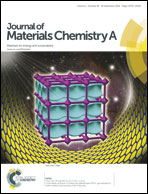Nanocups-on-microtubes: a unique host towards high-performance lithium ion batteries†
Abstract
In this work, unique carbonaceous nanocups, densely attached on a free-standing hollow microfibrous mat, were prepared via a mussel-inspired biomimetic polydopamine (PDA)-coating process using electrospun porous microfibers as the templates, followed by annealing. Electron microscopic studies show that the diameters and depths of the ellipsoid-shaped nanocups are in the range of a few hundred nanometers, and they have small openings of less than 100 nm, allowing the cups to act as nano-chambers to host other functional materials as well as nano-reactors for the synthesis of embedded nanostructures. To demonstrate the functions of such a unique hollow structure, the nanocups were used to host a MoS2 precursor, and through hydrothermal treatment, MoS2 nanosheets were effectively trapped in the nanocups. The MoS2-in-nanocups were used as an anode in lithium ion batteries. Good cyclability and excellent rate capacity (around 520 mA h g−1 at 2 A g−1) were achieved owing to the efficient charge transport provided by the good contact of the MoS2 nanosheets with the conductive nanocups and surrounding electrolyte. The nanocups could also act as buffering chambers to effectively accommodate the volume expansion of MoS2 during cycling.


 Please wait while we load your content...
Please wait while we load your content...